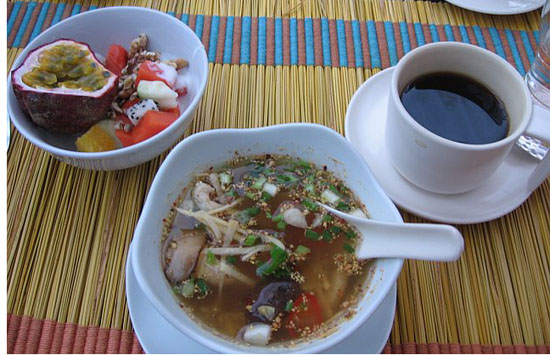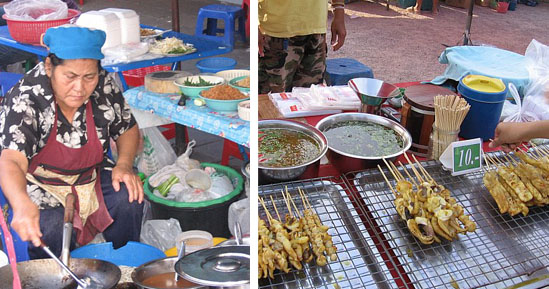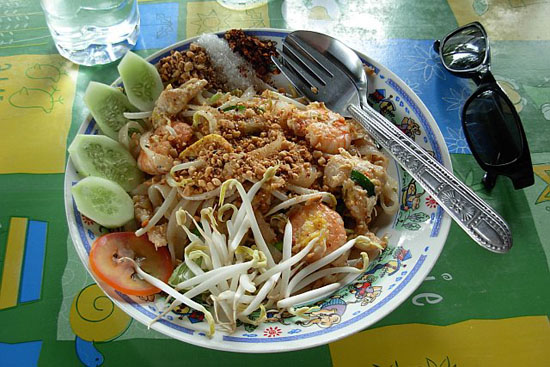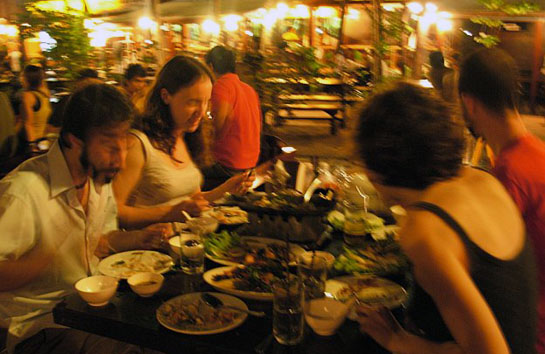I am thrilled to welcome my first guest blogger, Monica. My dear friends, Josh and Monica, who I miss like crazy, are living in Thailand for two years. Monica was kind enough to share photos and thoughts on the changes in her daily eating while living abroad.
If I had to summarize Thai food in one word it would be fresh. Whether it is meat on a stick, a plate of som tom, or a simple stir-fry, everything still tastes like it should. For minimal cost and effort one can eat healthy, flavorful food all of the time. Thais eat several, small meals a day, stopping at food stalls whenever hunger calls. For about 25 baht per serving, roughly 75 cents, one can stop frequently to satisfy any craving.

Thais typically start the day off with a bowl of noodle soup. To order, one simply identifies their noodle and meat of choice. Noodles are either thin (sen lek) or wide (sen yai) rice noodles or wheat noodles (bamee). Meat is typically chicken (gai) or pork (moo) and if you’re lucky a few intestines may be thrown in for a little extra flavor. Four condiments are usually added to the soup by the individual to taste: sugar, fish sauce, vinegar, and chili (and sometimes peanuts).

After breakfast, it’s anyone’s call. The staple is rice: either white rice (khao suey, literally “pretty” rice) or “sticky” rice (rice prepared by steaming it in a bamboo basket for over eight hours). The flavors can be as simple as a stir-fry of veggies flavored with ginger and soy sauce or as complex as those found in a beef salad (nom tok) prepared with lime juice, red onion, sea salt, cilantro, and fish sauce. Our favorites include perfectly fried chicken, amazingly grilled fish, som tom (papaya salad with a “dressing” made from tamarind juice, chili, lime juice, cane sugar, and fish sauce), and noodle soup with “red” pork (moo deng).
Desserts in Thailand are usually variations on one theme: gelatinous rice, coconut, and lotus or taro held together in a banana leaf. Baked goods are few and far between. Not having quite acquired a taste for these types of sweets, I turn instead to the fruit in order to satisfy my cravings. For 10 baht one can grab a half of pineapple, mango, papaya, or watermelon (to name only a few) each sweeter than the next. Fruit carts are ubiquitous on the street and ready to serve up nature’s candy anytime. Bananas and oranges are often also bought in bulk and make up in-between snacks throughout the day.

I honestly can say that I am never bored of Thai food. It offers so much variety and reaches far beyond what I believed Thai food to be from my experiences in the States. If I was forced to identify something that I miss from the States it would be wine. What we would consider a cheap bottle of wine in the States may run upwards of 20 USD here. But, I’ve taken to drinking beer, mostly Chang, a local favorite, which satisfies thirst wonderfully after a long, hot day. Cheese and dairy are also missing from Thai cuisine. So, munching on that brick of brie before dinner is only an option if you’re willing to hand over the cash at the grocery store stacked with imported goods. Instead, we simply stick to the local, fresh (and cheap) food which never fails to hit the mark.

